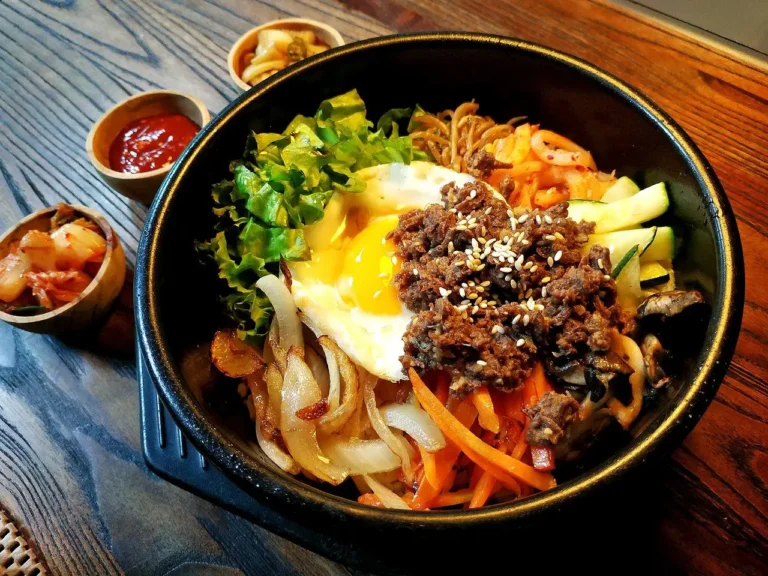Introduction: South Korean Cuisine
South Korean cuisine has gained popularity in recent years, offering a wide variety of dishes that are both healthy and flavorful. South Korean cuisine is built on the foundation of rice, vegetables, and meat, and is characterized by its bold, spicy, and umami flavors. Korean cuisine is also known for its fermented ingredients, which are used to add depth and complexity to many dishes.
South Korean cuisine has a rich history that dates back to ancient times, influenced by Chinese and Japanese cuisines, as well as its own unique cultural traditions. Today, South Korean cuisine represents a vibrant and diverse culinary landscape that offers something for everyone, from street food to high-end restaurants.
Fermented Flavors: Kimchi and Beyond
Fermented foods are a cornerstone of South Korean cuisine, and kimchi is perhaps the most well-known and beloved of them all. Made from fermented cabbage, radish, or other vegetables, kimchi is seasoned with garlic, ginger, and red pepper flakes, among other ingredients. The result is a tangy, spicy, and slightly sour condiment that is versatile enough to be used in many different dishes.
In addition to kimchi, South Korean cuisine also makes use of other fermented ingredients, such as doenjang (fermented soybean paste), gochujang (fermented red pepper paste), and jeotgal (fermented seafood). These ingredients are used to add depth and complexity to stews, soups, and sauces, and are a key part of the bold, umami flavors that define South Korean cuisine.
Spicy and Bold: Gochujang and Red Pepper
South Korean cuisine is known for its bold, spicy flavors that are achieved through the use of red pepper flakes, gochujang (fermented red pepper paste), and other chili-based seasonings. Gochujang is particularly important in Korean cuisine, and is used in a wide range of dishes, from stews and soups to marinades and dipping sauces.
In addition to gochujang, South Korean cuisine also makes use of other spicy ingredients, such as red pepper flakes, gochugaru (coarse red pepper powder), and wasabi. These ingredients add heat and depth to dishes, and are an essential part of the bold, complex flavors that make South Korean cuisine so distinctive.
Umami and Savory: Soy Sauce and Fish Sauce
South Korean cuisine is also known for its umami and savory flavors, which are achieved through the use of ingredients like soy sauce and fish sauce. Soy sauce, in particular, is a staple of Korean cuisine, and is used in a wide range of dishes, from stir-fries to marinades. Fish sauce is another important ingredient, particularly in coastal regions of South Korea, where seafood is a major part of the diet.
In addition to soy sauce and fish sauce, South Korean cuisine also makes use of other umami-rich ingredients, such as sesame oil, fermented soybean paste, and dried anchovies. These ingredients are used to add depth and richness to dishes, and are an important part of the complex, nuanced flavors that are a hallmark of South Korean cuisine.
Rice and Noodles: Mainstays of Korean Cuisine
Rice and noodles are the mainstays of South Korean cuisine, and are used in a wide range of dishes, from bibimbap (a rice bowl dish) to japchae (a stir-fried noodle dish). Rice is particularly important in Korean cuisine, and is often served at every meal. Korean rice is short-grain and sticky, and is typically steamed or boiled.
Noodles are also an important part of Korean cuisine, and come in many different varieties, from sweet potato noodles to thin wheat noodles. Noodles are used in a wide range of dishes, from soups and stews to stir-fries and salads. In addition to rice and noodles, South Korean cuisine also makes use of other grains, such as barley and millet, which are used in a variety of porridges and other dishes.
Unique Ingredients: From Ginseng to Seafood
South Korean cuisine is also known for its use of unique and unusual ingredients, many of which have medicinal properties. Ginseng, for example, is a root vegetable that is prized for its health benefits, and is used in many Korean dishes, including soups and teas. Other unique ingredients in Korean cuisine include perilla leaves, acorn jelly, and pine mushrooms.
Seafood is also an important part of South Korean cuisine, particularly in coastal regions. Popular seafood dishes in South Korea include hwe (raw fish dishes), grilled and steamed fish, and seafood stews. South Korean cuisine also makes use of a wide range of other ingredients, such as wild greens, edible flowers, and various types of mushrooms, which add depth and complexity to many dishes.

